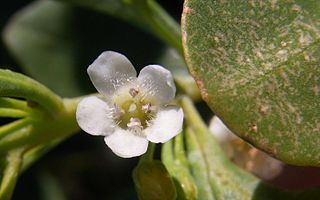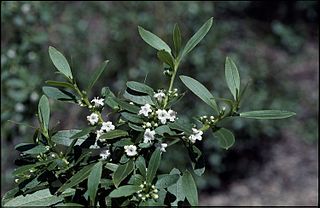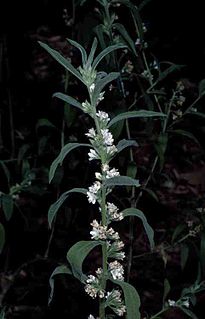
Eremophila oppositifolia, commonly known as weeooka, twin-leaf emu bush and mountain sandalwood, is a plant in the figwort family, Scrophulariaceae, and is endemic to Australia. It is a shrub or small tree with its leaves arranged in opposite pairs and has cream to red or sometimes maroon coloured flowers. It occurs in all mainland states, but not the Northern Territory.
Myoporum rapense is a plant in the figwort family, Scrophulariaceae and is endemic to French Polynesia and the Kermadec Islands. It is closely related to Myoporum laetum and there are two subspecies which are found on different island groups.
Myoporum rimatarense is a plant in the figwort family, Scrophulariaceae and is endemic to Rimatara Island in French Polynesia. It is only known from the type specimen collected in 1921 and 1934 and is presumed extinct.
Myoporum stokesii is a plant in the figwort family, Scrophulariaceae and is endemic to the island of Raivavae in French Polynesia. It is similar to the two other members of its genus on the island, Myoporum rapense and Myoporum rimatarense although the former has serrated leaves and the latter has wider leaves and differently shaped fruits.

Eremophila cuneifolia, commonly known as pinyuru, is a flowering plant in the figwort family, Scrophulariaceae and is endemic to the north-west of Western Australia. It is a spreading, sticky shrub with wedge-shaped leaves, coloured sepals and usually deep purple flowers.

Myoporum sandwicense, commonly known as naio, bastard sandalwood or false sandalwood is a species of flowering plant in the figwort family, Scrophulariaceae. It is a tree or shrub highly variable in its form, the size and shape of its leaves, in the number of flowers in a group and in the shape of its fruit. It is endemic to Hawaiʻi.

Myoporum petiolatum, commonly known as sticky boobialla, is a plant in the figwort family Scrophulariaceae, and is endemic to the south-east of continental Australia. For many years this species has been confused with the much less common species Myoporum viscosum from which it can be distinguished by its thinner, noticeably petiolate and non-odorous leaves.

Myoporum montanum, commonly known as waterbush or boobialla, is a shrub native to Australia, New Guinea and Timor. The species is extremely variable in size growth habit and leaf form, with three primary forms recognised. Its occurrence in many places is restricted to coastal regions, watercourses and other locales with more reliable water supplies. It was this association with water that gave rise to the name water bush.

Myoporum boninense is a plant in the figwort family, Scrophulariaceae. It is a shrub with thick, fleshy, glossy leaves, white flowers in small groups and shiny lilac to pale purple fruits. It grows in coastal heath in New South Wales and Queensland in Australia and on islands in the north west Pacific Ocean.

Myoporum brevipes, commonly known as the pale myoporum, is a plant in the figwort family, Scrophulariaceae. It is sometimes a prostrate, others an erect shrub. Its branches and leaves are warty and it has white or pink flowers, often spotted, followed by succulent white fruits. It generally grows in arid areas in South Australia but has also been found in Victoria and Western Australia.

Myoporum caprarioides, commonly known as slender myoporum, is a plant in the figwort family, Scrophulariaceae. It is a shrub with wart-like tubercles covering its branches and leaves, especially on the upper surface and white flowers spotted with mauve, or all blue-mauve, present for most of the warmer months.

Myoporum cordifolium, commonly known as Jerramungup myoporum, is a plant in the figwort family, Scrophulariaceae. It is a shrub with thin, stiff branches and tiny, heart-shaped leaves, both covered with wart-like tubercles. Single white flowers with purple spots develop in the leaf axils and are followed by wrinkled green or brown fruits. It is endemic to a small area in the south-west of Western Australia
Myoporum crassifolium is a plant in the figwort family, Scrophulariaceae. It is a shrub or small tree with thick, fleshy leaves and small groups of white flowers spotted with pink or purple. It is endemic to New Caledonia, Vanuatu and the Loyalty Islands and is a rich source of the essential oil, bisabolol.
Myoporum mauritianum is a flowering plant in the figwort family Scrophulariaceae and is endemic to a few volcanic islands in the Indian Ocean. It is a small, low-branched shrub with serrated leaves and small white flowers and usually grows on calcarenite within 20 metres (70 ft) of the sea.

Myoporum oppositifolium, commonly known as twin-leaf myoporum, is a plant in the figwort family, Scrophulariaceae. It is easily distinguished from others in the genus by the combination of glabrous leaves and branches, its opposite leaf arrangement and its serrated leaves. Its distribution is restricted to the extreme south-west of Western Australia.

Myoporum tetrandrum, commonly known as slender myoporum or boobialla is a plant in the figwort family, Scrophulariaceae. It is an erect and spreading shrub endemic to the south-west of Western Australia, common in moist areas and like most of the other members of its genus has bell shaped, star-like white flowers in the leaf axils.

Myoporum velutinum is a plant in the figwort family, Scrophulariaceae and is endemic to a small area near Esperance in Western Australia. It has similar flowers and fruits and grows in similar environments to Myoporum tetrandrum but differs from it and all other members of the genus by having hairs on the outer edge of the petals.

Myoporum wilderi, commonly known as Cook Islands myoporum or ngaio, is a plant in the figwort family, Scrophulariaceae and is endemic to the islands of Mangaia and Mitiaro in the Cook Islands. It is similar to Myoporum stokesii and Myoporum rimatarense which grow on other Pacific Islands. On the island of Raratonga it is used to add a scent to coconut oil.
Myoporum bontioides commonly known as ku jian lan, is a species of the flowering plant in the family Scrophulariaceae. It is a shrub growing in coastal areas of southern Japan and South China including beaches and estuaries where there are no large breaking waves.
Eremophila cuneata is a flowering plant in the figwort family, Scrophulariaceae and is endemic to the Shark Bay area of Western Australia. It is a rarely-seen, small shrub with wedge-shaped leaves and white to cream-coloured flowers.













